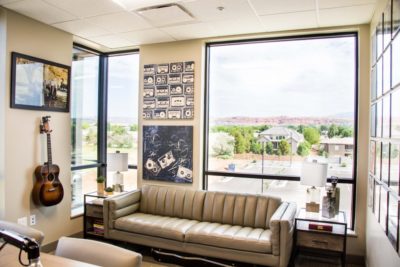
CONTRIBUTED CONTENT — Living with chronic pain can be a daily battle. At Desert Pain Specialists, patients aren’t just “treated” – they are seen, heard, understood and supported throughout their pain management journey.

The board-certified physicians at Desert Pain strive to improve patient quality of life through innovative pain management solutions. They treat all types of acute and chronic pain, including back pain, neck pain, sciatica, neuropathy, migraines and sports injuries.
“We’re up-to-date on so many treatment options that we have for our patients,” said Dr. Rachel Allen, a pain management physician and anesthesiologist with Desert Pain. “We will guide them and walk them through what the best options are for them.”
Epidural steroid injections
Back pain is among the most common health complaints afflicting Americans today and may originate from a variety of sources, including bulging discs, sciatica, bone spurs and arthritis. Allen said that epidural steroid injections can restore mobility and improve quality of life for many patients struggling with chronic back pain.
Epidural injections use corticosteroid, which decreases inflammation in the affected region and provides pain relief that can last up to three months or more. The epidural space lies outside of the spinal cord and extends from the base of the skull to the sacrum. Injections performed in the lower or mid-back can help alleviate related leg pain, Allen said.
“We can also do that all the way up the spine for people who have pain in their neck that goes down their arms,” she added.
Spinal cord stimulation
For patients who have exhausted all nonsurgical options to alleviate their chronic back pain, Allen said that spinal cord stimulation may provide relief at last. A spinal cord stimulator is an implanted device that delivers electrical pulses directly into the spinal cord to interrupt nerve impulses that produce pain.

The process begins with an electrode that is temporarily inserted into the skin and connected to a stimulator, which the patient can turn on and off. The physician will conduct a trial to determine the appropriate pulse strength for maximum pain relief.
“Before anything is implanted, you get to take this home,” Allen said. “We place it in the epidural space and watch how much relief they experience as we program it. Often, people experience phenomenal relief within a few days.”
Kyphoplasty
Acutely painful spinal compression fractures are more common in older adults as a result of osteoporosis or falls but may also occur during a traumatic injury. Kyphoplasty is a minimally invasive treatment option that can provide immediate pain relief and restore height to the vertebral column, Allen said.
During kyphoplasty, the physician inserts a tiny balloon into the middle of the broken vertebra. The balloon is then inflated, creating a bit of space that is filled with bone cement to stabilize the fracture. Allen said that patients typically resume their normal daily activities soon after undergoing kyphoplasty.
“A lot of patients experience relief the day of the procedure,” she added. “I can’t tell you how many times I’ve seen patients walk in with excruciating pain and walk out with a big smile on their face.”
Radiofrequency ablation
Patients suffering from chronic lower back or neck pain as well as joint pain caused by arthritis may benefit from radiofrequency ablation, Allen said. This procedure uses an electrical current from radio waves to heat surrounding nerve tissue and reduce pain signals to the affected area. Under fluoroscopic guidance, the physician will inject a microelectrode into the target region and begin the stimulation process.

“We know right where those little nerves live that carry those pain signals, and we can send that frequency in to stop those nerves from talking to each other,” Allen said.
Radiofrequency ablation is a safe outpatient procedure that provides fast relief. Allen said the results may last a year or even longer for some patients.
Allen encourages anyone with concerns about acute and chronic pain or questions on specific procedures to reach out to Desert Pain.
Desert Pain was founded in 2007 by Dr. Court Empey, a St. George native who recognized an unfulfilled need in the community for the treatment of chronic pain. Today, the practice includes five board-certified anesthesiologists with fellowship training in pain management joined by eight physician assistants and nurse practitioners.
“That’s many years of education, training and experience between all of us,” Allen said.
Written by ALEXA MORGAN for St. George News.
• S P O N S O R E D C O N T E N T •
Resources
- Desert Pain Specialists | Telephone: 435-216-7000 | Email: [email protected] | Website.
- Locations:
- St. George: 617 E. Riverside Drive, Suite 301.
- Hurricane: 48 S. 2500 West, Suite 110.
- Cedar City: 1760 N. Main St.
- Beaver: 68 N. Main St.
- Panguitch: 200 N. 400 East.
- Kanab: 460 E. 300 South, Suite 4.
- Mesquite, Nevada: 340 Falcon Ridge Parkway, Suite 600.
Copyright St. George News, SaintGeorgeUtah.com LLC, 2021, all rights reserved.